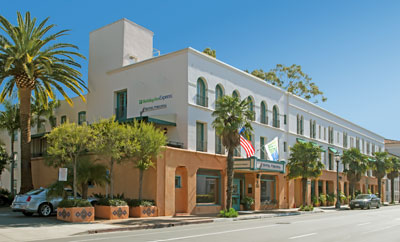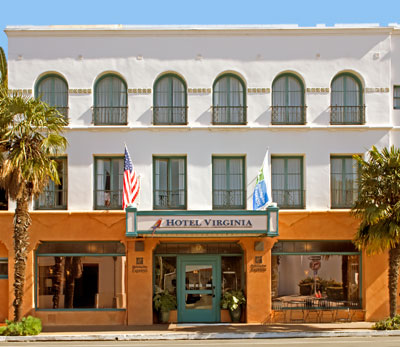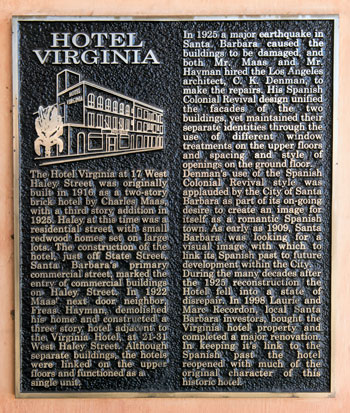National Register of Historic Places in Santa Barbara County
Hotel Virginia
17 and 23 West Haley Street
Santa Barbara
Most cities in California were inspired by the City Beautiful Movement during the early 20th century.
City Beautiful plans were commissioned and prepared for San Francisco, Los Angeles, Sacramento, San Diego, and many other smaller cities in the state. A common thread in all of these plans was the desire to develop design guidelines that emphasized architectural thematic consistency for major buildings and structures. These efforts were rarely successful.
The City of Santa Barbara actually enforced its guidelines as early as the 1920s.
A devastating earthquake leveled much of the city in 1925, allowing city planners to rebuild from scratch.
Santa Barbara was not alone in this respect. Many saw the 1906 earthquake in Northern California as an opportunity for San Francisco to rebuild along Beaux Arts lines as recommended in its City Beautiful Plan.
San Francisco did not follow its plan.
The post-1906 city was different from the pre-1906 city but not because San Francisco enforced its design criteria.
Source: Adapted from the NRHP nomination submitted in the year 2000.

A marker mounted on the wall near the front door reads:
Hotel Virginia
The Hotel Virginia at 17 West Haley Street was originally built in 1916 as a two-story brick hotel by Charles Maas, with a third story addition in 1925. Haley at this time was a residential street with small redwood homes set on large lots. The construction of the hotel just off State Street, Santa Barbara's primary commercial street, marked the entry of commercial buildings on Haley Street. In 1922 Maas' next door neighbor, Freas Hayman, demolished his home and constructed a three story hotel adjacent to the Virginia Hotel, at 31-31 West Haley Street. Although separate buildings, the hotels were linked on the upper floors and functioned as a single unit.
In 1925 a major earthquake in Santa Barbara caused the buildings to be damaged, and both Mr. Maas and Mr. Hayman hired the Los Angeles architect, C. K. Denman, to make the repairs. His Spanish Colonial Revival design unified the facades of the two buildings, yet maintained their separate identities through the use of different window treatments on the upper floors and spacing and style of openings on the ground floor. Denman's use of the Spanish Colonial Revival style was applauded by the City of Santa Barbara as part of its on-going desire to create an image for itself as a romantic Spanish town. As early as 1909, Santa Barbara was looking for a visual image with which to link its Spanish past to future development within the City. During the many decades after the 1925 reconstruction the Hotel fell into a state of disrepair. In 1998 Laurie and Marc Recordon, local Santa Barbara investors, bought the property and completed a major renovation. In keeping it's [sic] link to the Spanish past the hotel reopened with much of the original character of this historic hotel.



